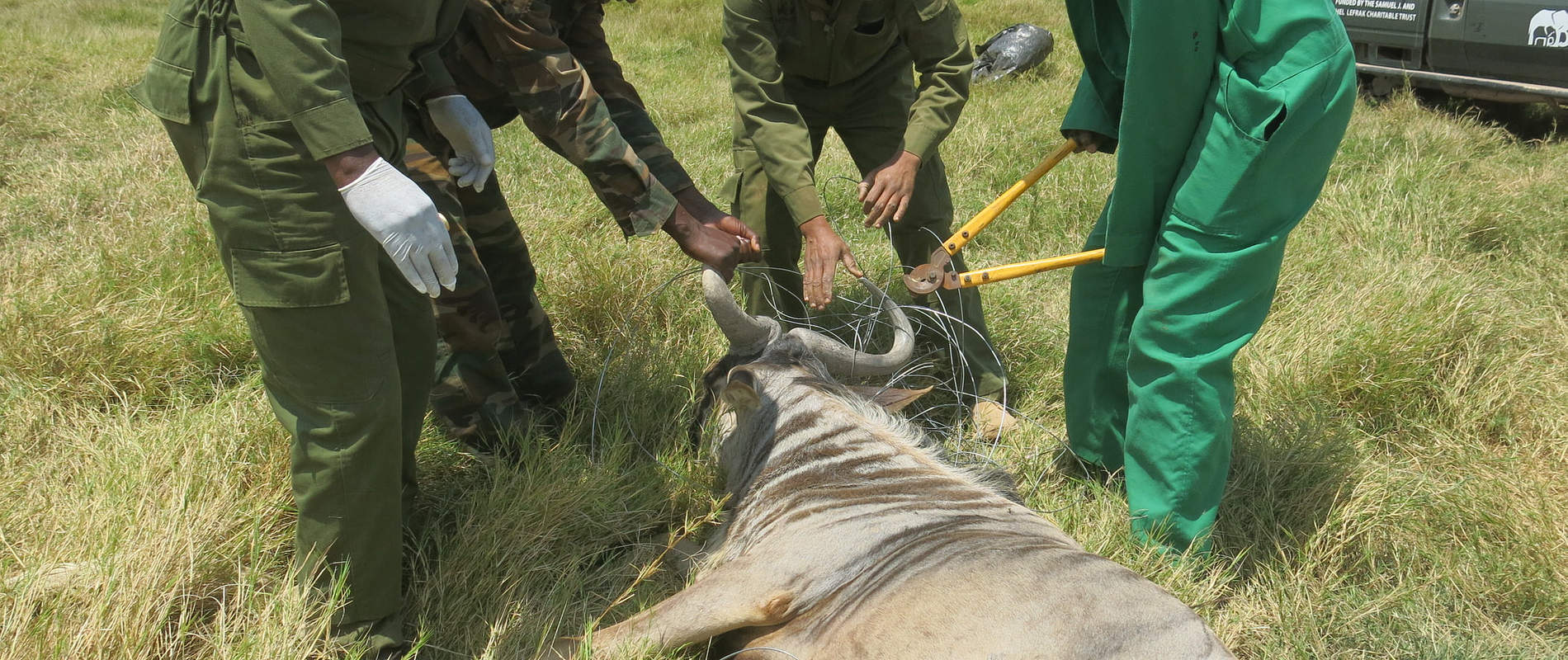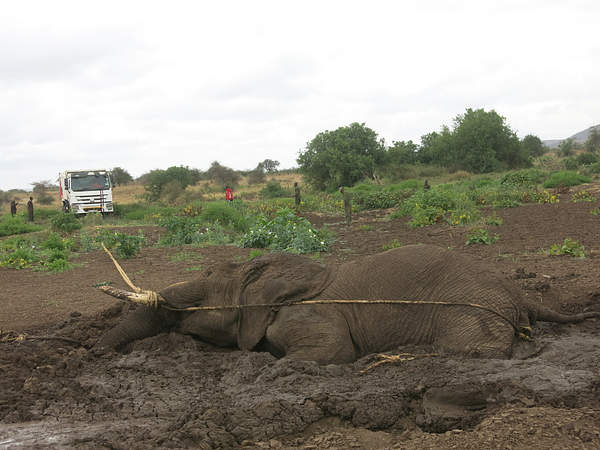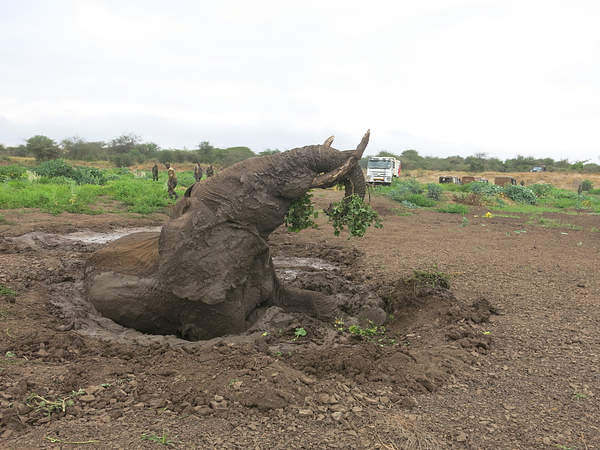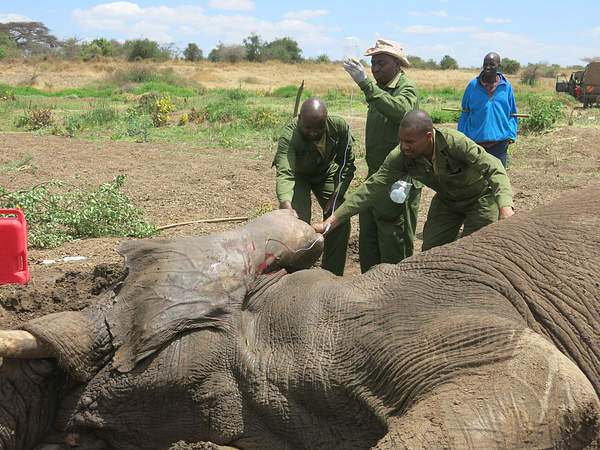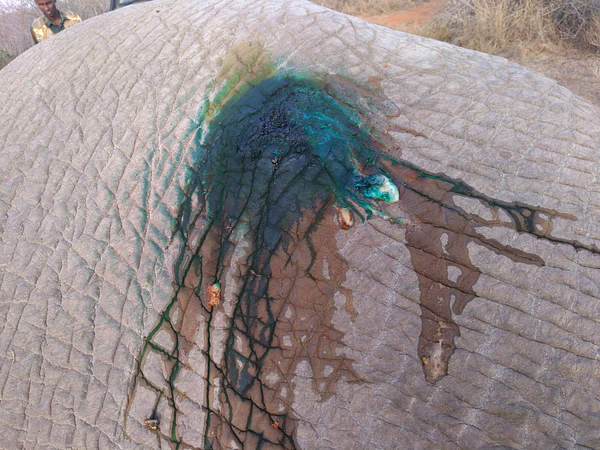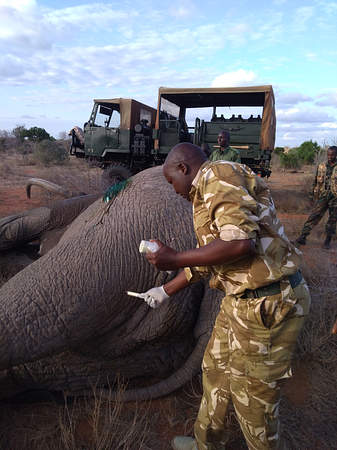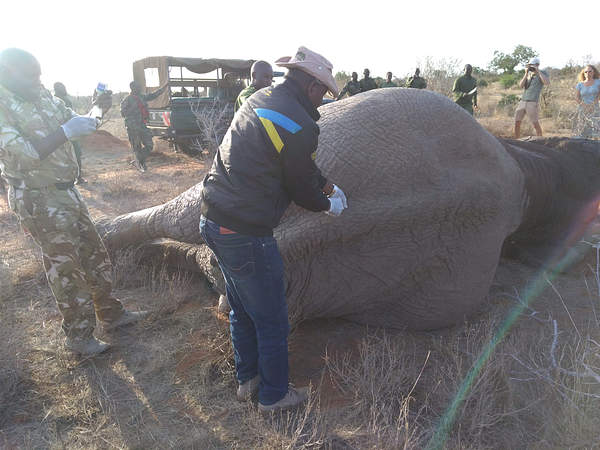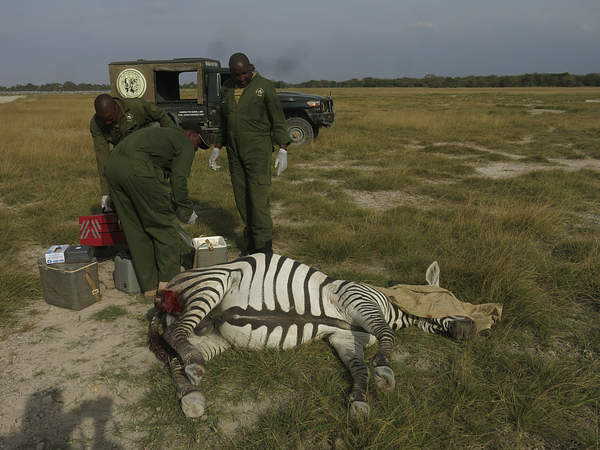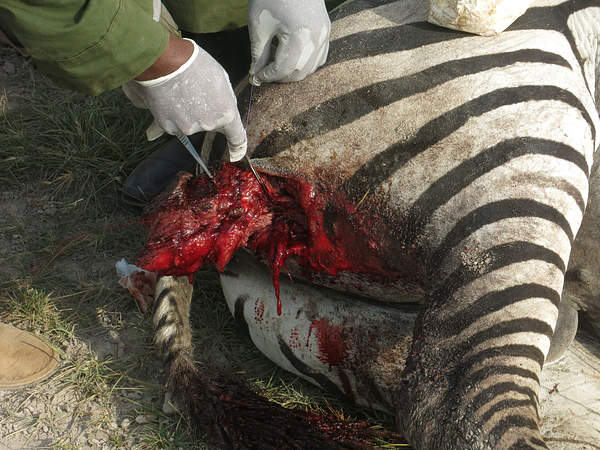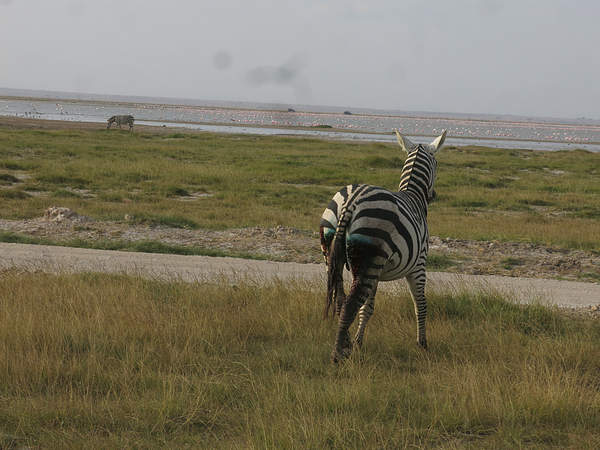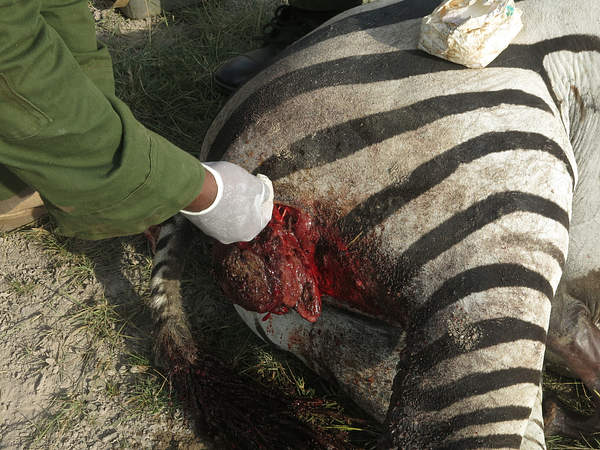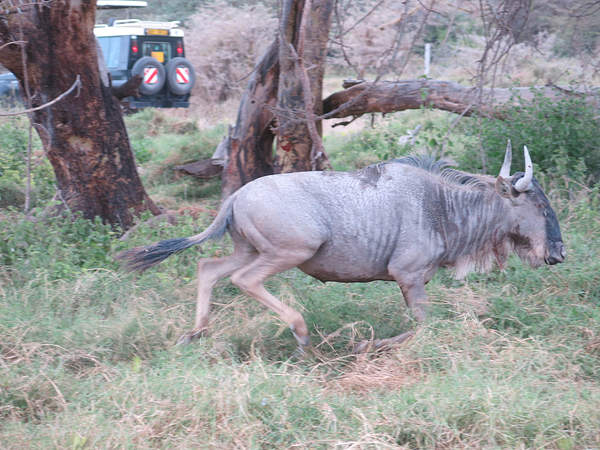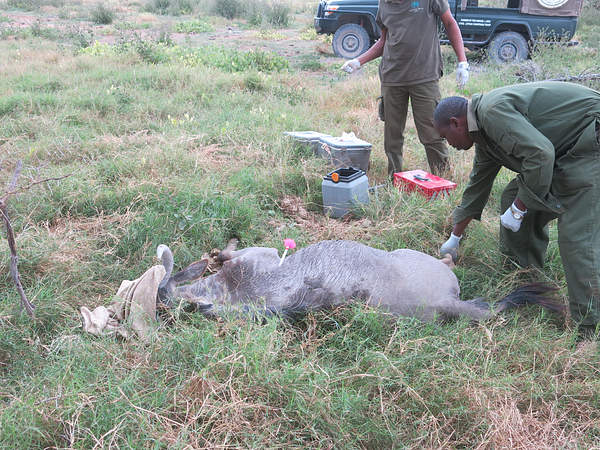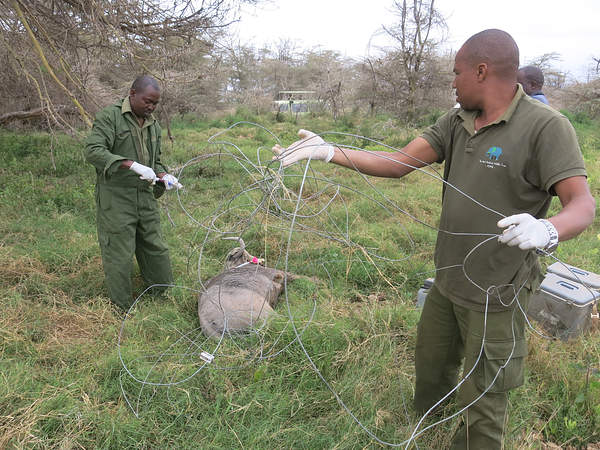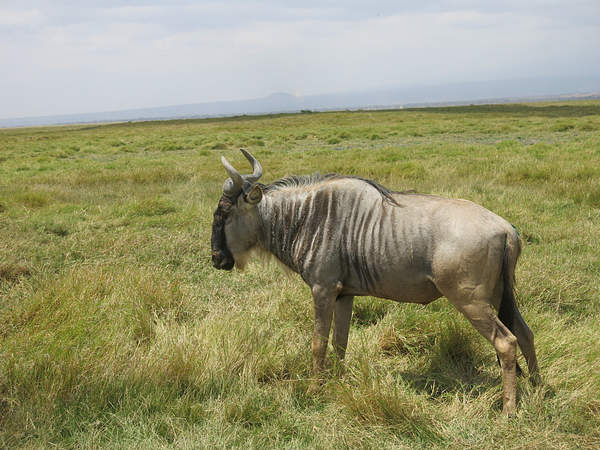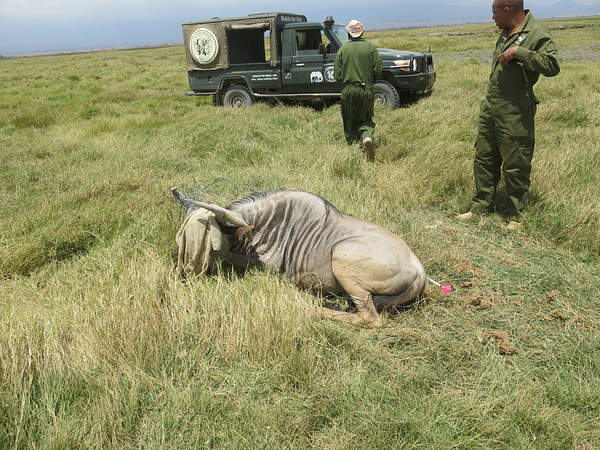Nine wildlife cases were reported and attended by Amboseli Mobile Veterinary Unit during the month of August 2018. Seven cases were clinical and treatment was necessary while two did not warrant any therapeutic intervention.
Of the five patients that required treatment, one elephant with spear wounds treated at Satao-Kulalu area in Tsavo East National Park, an elephant rescued from a sticky muddy pool at Kilunyet area in Chyulu Hills National Park and a male zebra with a bleeding tumor. Two wildebeests entangled in a loose fence wire were de-snared at Amboseli National Park The case of a giraffe with hind limb fracture was attended but was found dead on vet team arrival. Response time was immediate for all reported cases and all of them received attention within the day of reporting.
CASE#1 HIND LIMB FRACTURE IN A GIRAFFE
Date: 08/08/2018
Species: Masai Giraffe (Giraffe Camelopardalis)
Sex: Male
Age: Adult
Location: Kimana Group Ranch
History: The Amboseli Mobile Vet Unit received a report of a Giraffe with a swollen leg from Big Life Foundation. The adult giraffe was located at Kimana Group Ranch, but was found dead on arrival.

Examination: The giraffe had a fracture on the left hind limb. The fracture wound was old and the giraffe was in good body condition. The giraffe is estimated to have spent some time with the fractured leg before death. There was evidence that the giraffe may have been trapped in a nearby pit which may have led to the giraffe fracturing his leg. The evidence suggests that the giraffe may have struggled for some time before eventually succumbing to his wounds.

Conclusion: Cause of death was not clear, but the giraffe probably went into shock from the pain which most likely would have lead to sudden unexpected death (SUD) as trauma is the usual cause of SUD.
CASE#2 RESCUE OF AN ELEPHANT BULL TRAPPED IN A WETLAND
Date: 12/08/2018
Species: African Elephant (Loxodonta Africana)
Sex: Male
Age: Adult
Location: Kilunyet area
History: KWS received reports of an adult male elephant stuck in a marshy water pan. A team composed of Rangers from KWS-Chyulu Hills National Park and Big Life Foundation attempted to rescue the bull from the wetland but were not successful. The Amboseli Veterinary Unit was then called in the evening to assist in the rescue.

Rescue, examination and treatment: The adult bull approximately 35 years old was stuck in a mud pool at Kilunyet area. The area was mushy and hard to approach with a vehicle. This particular challenge made the rescue very difficult with the Amboseli Veterinary Unit vehicle also becoming stuck. As the vehicles kept getting stuck themselves the team had to come up with another plan. The team eventually managed to pull the large bull from the mud using three land cruisers, two heavy commercial Lorries, and a JCB.
However, the bull was inactive and could not stand. Upon further examination it was found that the elephant was weak and exhausted. A whole day of therapy with Dextrose and Sodium Lactate assisted the animal in gaining energy and strength. The elephant finally stood up, with some assistance from a land cruiser that pulled a rope that was lightly attached around his tusk, at around 6pm on the 14th of August 2018.

CASE#3 TREATMENT OF A WOUNDED BULL ELEPHANT
Date: 16/08/2018
Species: African Elephant (Loxodonta Africana)
Sex: Male
Age: Adult
Location: Satao-Kulalu, Tsavo East National Park
History: A male elephant presenting with a white colored discharge was sighted at Satao-Kulalu area in Tsavo East National Park.
Immobilization, examination and treatment: The bull was located and darted by helicopter using 18mgs Etorphine Hcl. Induction time was about 12 minutes after darting and the bull was immobilized resting on lateral recumbency. Examination exposed a deep wound on the lateral part of the left hind leg. Foot long forceps were used to probe for foreign material, remove pus and dead debris. No foreign matter was revealed but the excess pus and debris were debrided using Hydrogen Peroxide. Betamox and Dexamethasone was administered intramuscularly to counter bacterial infection, reduce the inflammation and minimize pain. Oxytetracycline aerosol spray was topically applied to prevent a fly attack on the wound.

Reversal and prognosis: The anesthesia was reversed using 48mgs of Diprenorphine administered intravenously through a prominent ear vein. The elephant rose up and walked away after 2 minutes. Prognosis for full recovery is good as the animal demonstrated high chances of quick and sure recovery.

CASE#4 TREATMENT OF A BULL ELEPHANT AT TSAVO EAST NATIONAL PARK
Date: 16/08/2018
Species: African Elephant (Loxodonta Africana)
Sex: Male
Age: Adult
Location: Satao-Kulalu, Tsavo East National Park

History: The Amboseli Veterinary Unit received a report of a male elephant with a pus discharging abdominal swelling.
Immobilization, examination and treatment: The male elephant was restrained by chemical immobilization using 18mgs of Etorphine Hydrochloride darted from a helicopter. Puncture of the abdominal swelling assisted in draining the pus while the old and infected wound tissue was debrided using Hydrogen Peroxide. The wound was disinfected with Tincture of Iodine solution and Amoxicillin (Betamox 200ml) was administered intramuscularly as an antibiotic.
Reversal and prognosis: The anesthesia was reversed using 48mgs of Diprenorphine administered through a prominent ear vein. The elephant rose up after 2 minutes. Prognosis for full recovery is good.
Our Mobile Vet Units are in the field every day saving wild lives
CASE#5 TREATMENT OF A ZEBRA WITH A BLEEDING TUMOUR
Date: 22/08/2018
Species: Common Zebra (Equus quagga)
Sex: Male
Age: Adult
Location: Amboseli National Park
History: The Amboseli Veterinary Unit whilst on patrol spotted a male zebra with a bleeding wound on his hind right leg, which appeared to be a tumour. The zebra was in good body condition and feeding well but as the wound was bleeding the team thought it best to intervene.

Immobilization, examination and treatment: The zebra was located and darted from a vehicle. A cocktail of 5 mg of Etorphine hydrochloride and 60mg Azaperone was used to anaesthetize the zebra. The stallion was recumbent in about 10 minutes after darting. Physical examination revealed a swelling growing from the muscular tissue at the gluteus region of the left hind leg. The growth had a bleeding wound beside it. The wound was rinsed clean water, as well as the adjacent wound area, the tumor was removed and the wound was sutured.
Betamox and Dexamethasone were administered intramuscularly for prophylaxis. A multivitamin was administered intramuscularly to reduce stress and increase vitality. Oxytetracycline spray was topically applied to reduce infection and to deter flies.
CASE#6 WILDEBEEST SNARED IN LOOSE FENCE WIRE
Date: 24/08/2018
Species: Wildebeest (Coinechaetes taurinus sp.)
Sex: Male
Age: Adult
Location: Near Ol Tukai Lodge, Amboseli National Park

History: A tourist reported a wildebeest entangled in a loose fence wire near Ol Tukai Lodge in Amboseli National Park.
Immobilization, examination and treatment: The wildebeest was located and darted from a vehicle using a Danject darting gun. The immobilization dart contained a mixture of 5 mg of Etorphine Hydrochloride and 60mg Azaperone. The wildebeest became fully anesthetized after 8 minutes. Physical examination revealed no harm due to the wire. The noose was large and removal was easily done by hand. Samples were collected for future disease investigation work.
CASE#7 WILDEBEEST CAUGHT IN A LOOSE SNARE WIRE
Date: 30/08/2018
Species: Wildebeest (Coinechaetes taurinus sp.)
Sex: Male
Age: Adult
Location: Amboseli National Park
History: A wildebeest with a snare wire was sighted and reported by KWS Operation Rangers at Junction 44 in Amboseli National Park.

Immobilization, examination and treatment: The wildebeest was located and darted from a vehicle using a mixture of 5 mg of Etorphine Hcl and 60mg Azaperone. The animal was recumbent in 9 minutes. On examination, the wire was loose and had caused no harm. Removal was done by hand after cutting the wire with a wire cutter. The wildebeest was administered 10 ml of Amoxicillin (Betamox) intramuscularly to prevent secondary bacterial infection.
CASE#8 OBSERVATION OF AN ELEPHANT CALF WITH A SMALL WOUND
An elephant calf, being a twin, was sighted with a flesh wound along the spine. The wound was shallow and pinkish in color and did not warrant treatment as it was not infected and the prognosis for full recovery was good.
CASE#9 REPORT OF AN INJURED BULL ELEPHANT
The team received a report from the Elephant Trust of a bull with a swelling at the perineal region. Efforts to trace the bull were to no avail. However, Big Life Foundation Tanzania reported that the bull had been treated by the Tanzania Wildlife Research and Horse Farm, on the 22nd of August.
Acknowledgement
Report by KWS Vet Dr Kariuki Edward. We thank the David Sheldrick Wildlife Trust (DSWT) for material support and Mobile Unit funding, KWS for logistical support and security, Big Life Foundation for constant reporting and monitoring of distressed wild animals. Your support has gone a long way to improve the welfare of wildlife and conservation in Kenya.
